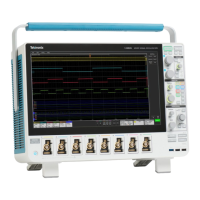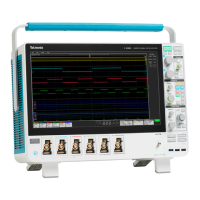Commands listed in alphabetical order
Syntax
SEARCH:SEARCH
<x>:TRIGger:A:TYPe
{EDGE|RUNT|TRANsition|PULS EWidth|TIMEOut|LOGIc|SETHold|
WINdow|Bus}
SEARCH:SEARC
H<x>:TRIGger:A:TYPe?
Arguments
EDGE triggers when the source input signal amplitude crosses the specified level
in the direc
tion given by the slope.
NOTE. Some trigger types are optional.
RUNT trigg
ers when a pulse crosses the first preset voltage threshold but
does not cross the second preset threshold before recrossing the first. The
thresholds are set with the SEARCH:SEARCH<x>:TRIGger:A:RUNt:HIGH and
SEARCH:SEARCH<x>:TRIGger:A:RUNt:LOW THRESHOLD commands.
TRANsition triggers when a pulse crosses both thresholds in the same direction
as the specified polarity and the transition time between the two threshold
crossings is grea t er or less than the specified time delta.
PULSEWidth triggers on input signal source pulses that are
inside or outside of the given time range specified by
SEARCH:SEARCH<x>:TRIGger:A:LOGIc:PATtern:WHEn:LESSLimit and
SEARC
H:SEARCH<x>:TRIGger:A:LO GIc:PATtern:WHEn:MORELimit.
The polarity is selected using the SEARCH:SEARCH<x>:TRIGger:A:RUNT:
POLarity command.
TIMEOut triggers on an input signal source that stays above, stays below, or stays
either above or beow the trigger level for a given time.
LOGIc specifies that a search occurs when specified conditions are met, and is
controlled by the SEARCH:A:LOGIc commands.
SETHold triggers on a functional pattern combination of one to three data sources
at the time of the clock transition.
WINdow triggers on an input s ignal source that enters or exits the horizontal band
defined by the two trigger levels.
Bus specifies that a search occurs when a communications signal is found.
Examples
SEARCH:SEARCH1:TRIGGER:A:T YPE RUNT sets the trigger type setting for
search 1 t o RUNT.
SEARCH:SEARCH1:TRIGGER:A:T YPE? might return
:SEARCH:SEARCH1:TRIGGER:A: TYPE EDGE, indicating that the trigger type
setting for search 1 is set to EDGE.
MSO54, MSO56, MSO58, MSO58LP Programmer 2-745
